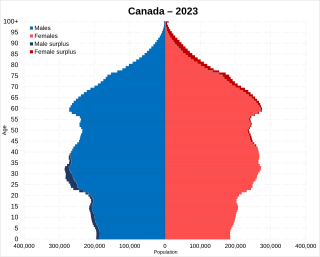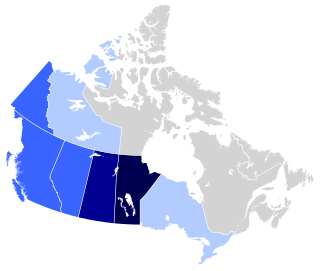
Statistics Canada conducts a country-wide census that collects demographic data every five years on the first and sixth year of each decade. The 2021 Canadian census enumerated a total population of 36,991,981, an increase of around 5.2 percent over the 2016 figure. It is estimated that Canada's population surpassed 40 million in 2023 and 41 million in 2024. Between 1990 and 2008, the population increased by 5.6 million, equivalent to 20.4 percent overall growth. The main driver of population growth is immigration, with 6.2% of the country's population being made up of temporary residents as of 2023, or about 2.5 million people. Between 2011 and May 2016, Canada's population grew by 1.7 million people, with immigrants accounting for two-thirds of the increase.

Ukrainian Canadians are Canadian citizens of Ukrainian descent or Ukrainian-born people who immigrated to Canada.
Spanish Canadians are Canadians of full or partial Spanish heritage or people who hold a European Union citizenship from Spain as well as one from Canada. They likely also include many Canadians of Latin-American ethnic origin who use the term "Spanish" as a panethnic ethnonym rather than only their specific country of ancestry. For example, someone whose familial origins are from El Salvador, Honduras, Colombia or Guatemala may call themself "Spanish" to identify with the larger Spanish speaking community. See Latin American Canadian for more information.

Polish Canadians are citizens of Canada with Polish ancestry, and Poles who immigrated to Canada from abroad. At the 2016 Census, there were 1,106,585 Canadians who claimed full or partial Polish heritage.
Lebanese Canadians are Canadians of Lebanese origin. According to the 2016 census there were 219,555 Canadians who claimed Lebanese ancestry, showing an increase compared to the 2006 census, making them by far the largest group of people with Arabic-speaking roots. As of the 2016 census, they are also one of the largest communities of Asian origin in the country.
Haitian Canadians are Canadians of Haitian descent or Haiti-born people who reside in Canada. As of 2016, more than 86% of Haitian Canadians reside in Quebec.
Afghan Canadians are Canadians with ancestry from Afghanistan. They form the second largest Afghan community in North America after Afghan Americans. Their ethnic origin may come from any of the ethnic groups of Afghanistan, which include Pashtun, Tajik, Uzbek, Hazara, Turkmen, etc. In the Canada 2016 Census about 83,995 Canadians were from Afghanistan.

Russian Canadians comprise Canadian citizens of Russian heritage or Russians who immigrated to and reside in Canada. According to the 2021 Census, there were 548,140 Canadians who claimed full or partial Russian ancestry. The areas of Canada with the highest percentage population of Russian Canadians are the Prairie Provinces.
The demographics of Toronto, Ontario, Canada make Toronto one of the most multicultural and multiracial cities in the world. In 2021, 57.0 percent of the residents of the metropolitan area belonged to a visible minority group, compared with 51.4 percent in 2016, and 13.6 percent in 1981. Toronto also has established ethnic neighbourhoods such as the multiple Chinatowns, Corso Italia, Little Italy, Little India, Greektown, Koreatown, Little Tokyo, Little Jamaica, Little Portugal, Little Malta, Roncesvalles (Polish), and Bloor West Village (Ukrainian), all of which celebrate the city's multiculturalism. Data from the suburban municipalities are also included for some metrics as most of these municipalities are part of the Toronto CMA.
Laotian Canadians, are Canadian citizens of Laotian origin or descent. In the 2016 Census, 24,580 people indicated Laotian ancestry. Bilateral relations between Canada and Laos were established in 1954 with the formalization of the independence of the Kingdom of Laos from France. In August 2015, Canada's first resident diplomat opened the Office of the Embassy of Canada in Vientiane, Laos.
Welsh Canadians are Canadian citizens of Welsh descent or Wales-born people who reside in Canada.
Barbadian Canadian or Bajan Canadians are Canadian citizens of Barbadian descent or Barbados-born people who reside in Canada. According to the 2016 Census 37,780 Canadians claimed full or partial Barbadian ancestry. Barbadian Canadians have the highest median income and the lowest incidence of poverty among Black Canadian groups. Barbadians first start migrating to Nova Scotia in the early 1900s settling largely in the neighbourhood of Whitney Pier in Sydney. In Cape Breton, they established chapters of the United Negro Improvement Association and the African Orthodox Church. As of 2016, over 70% of the Bajan population in Canada resides in Ontario.

Alberta has experienced a relatively high rate of growth in recent years, due in large part to its economy. Between 2003 and 2004, the province saw high birthrates, relatively high immigration, and a high rate of interprovincial migration when compared to other provinces. Approximately 81% of the population live in urban areas and only about 19% live in rural areas. The Calgary–Edmonton Corridor is the most urbanized area in Alberta and is one of Canada's four most urban regions. Many of Alberta's cities and towns have also experienced high rates of growth in recent history. From a population of 73,022 in 1901, Alberta has grown to 4,262,635 in 2021 and in the process has gone from less than 1.5% of Canada's population to 11.5%. It is the fourth most populated province in Canada. Between the 2016 and 2021 censuses, the Alberta population grew by 4.8%.
Egyptian Canadians are Canadian citizens of Egyptian descent, first-generation Egyptian immigrants, or descendants of Egyptians who emigrated to Canada. According to the 2011 Census there were 73,250 Canadian citizens who are from Egypt, having an increase compared to those in the 2006 Census.
Nordic and Scandinavian Canadians are Canadian citizens with ancestral roots in the Nordic countries and/or Scandinavia
Cambodian Canadians are Canadians of Cambodian ethnic origin or descent. There are a total of 38,490 Canadian Cambodians, most of whom reside in Toronto and Montreal.
Belgian Canadians are Canadian citizens of Belgian ancestry or Belgium-born people who reside in Canada. According to the 2011 census there were 176,615 Canadians who claimed full or partial Belgian ancestry. It encompasses immigrants from both French and Dutch-speaking parts of Belgium.
Ghanaian Canadians are a Canadian ethnic group of full or partial Ghanaian ancestry. Ghanaians who became naturalized citizens of Canada preferably refer to themselves as Ghanaian Canadians.

Yugoslav Canadians are Canadians of full or partial Yugoslav ancestry. At the 2016 Census, the total number of Canadians whose origins lie in former Yugoslavia, majority of whom indicated specific ethnic origin, was 386,340 or 1.12% of the total population.














